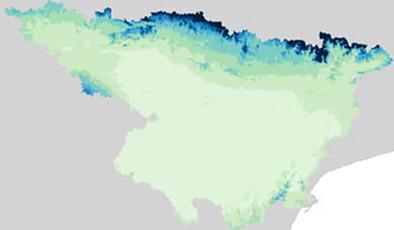当前位置:
X-MOL 学术
›
Int. J. Climatol.
›
论文详情
Our official English website, www.x-mol.net, welcomes your
feedback! (Note: you will need to create a separate account there.)
Evaluation of gridded rain‐gauge‐based precipitation datasets: Impact of station density, spatial resolution, altitude gradient and climate
International Journal of Climatology ( IF 3.5 ) Pub Date : 2021-01-11 , DOI: 10.1002/joc.7003 Andrés Merino 1 , Eduardo García‐Ortega 1 , Andrés Navarro 1 , Sergio Fernández‐González 2 , Francisco J. Tapiador 3 , José Luis Sánchez 1
International Journal of Climatology ( IF 3.5 ) Pub Date : 2021-01-11 , DOI: 10.1002/joc.7003 Andrés Merino 1 , Eduardo García‐Ortega 1 , Andrés Navarro 1 , Sergio Fernández‐González 2 , Francisco J. Tapiador 3 , José Luis Sánchez 1
Affiliation

|
Gridded precipitation datasets have been developed for data assimilation and evaluation tasks of weather and climate models and for climate analyses. Gridded data uncertainty evaluation is crucial to understand the limitations and feasibility. The development of high‐resolution daily gridded precipitation datasets is desirable, but several factors need to be considered, namely rain gauge station availability, their spatial distribution, and orographic and climate characteristics of a study area. Quality assessment of gridded datasets can present difficulties when the influence of these factors is not thoroughly analysed. The main objective of this study was a detailed validation of precipitation grids based on four factors, that is, station density used for grid construction, grid spatial resolution, station altitude, and climate type. To this end, 18 grids were built using six spatial resolutions (0.01°, 0.025°, 0.05°, 0.1°, 0.2° and 0.4°) and three station densities (25, 50 and 75% of all available stations). Results indicate larger differences among the grids as a function of analysed factors. Station density was found to be the main factor, whereas grid spatial resolution had minor importance. However, the latter factor becomes more relevant in areas with strong altitude gradients and when a high station density is available. In addition, weak and moderate precipitation is overestimated on daily grids, whereas heavy precipitation cells are less frequent, reducing data variability. On the contrary, monthly and annual aggregates present less deviation from the observed distribution than daily comparisons. These findings question the applicability of the daily grid datasets for validation studies and climate analysis on a grid cell level.
中文翻译:

评估基于栅格的雨量计降水数据集:站密度,空间分辨率,高度梯度和气候的影响
已开发出栅格化降水数据集,用于天气和气候模型的数据同化和评估任务以及气候分析。网格数据不确定性评估对于了解局限性和可行性至关重要。开发高分辨率的每日网格化降水数据集是可取的,但是需要考虑几个因素,即雨量计站的可用性,其空间分布以及研究区域的地形和气候特征。如果未充分分析这些因素的影响,则网格化数据集的质量评估可能会遇到困难。这项研究的主要目的是基于四个因素对降水网格进行详细的验证,即用于网格构建的站点密度,网格空间分辨率,站点高度和气候类型。为此,使用六个空间分辨率(0.01°,0.025°,0.05°,0.1°,0.2°和0.4°)和三个站点密度(所有可用站点的25%,50%和75%)构建了18个网格。结果表明,网格之间的较大差异是所分析因素的函数。发现站密度是主要因素,而网格空间分辨率的重要性较小。但是,后一个因素在海拔梯度较大的地区以及高站台密度可用时变得更加重要。此外,每天的网格上高估了弱和中度降水,而沉重的降水单元则不那么频繁,从而降低了数据的可变性。相反,与每日比较相比,月度和年度总计与观察到的分布的偏差较小。
更新日期:2021-01-11
中文翻译:

评估基于栅格的雨量计降水数据集:站密度,空间分辨率,高度梯度和气候的影响
已开发出栅格化降水数据集,用于天气和气候模型的数据同化和评估任务以及气候分析。网格数据不确定性评估对于了解局限性和可行性至关重要。开发高分辨率的每日网格化降水数据集是可取的,但是需要考虑几个因素,即雨量计站的可用性,其空间分布以及研究区域的地形和气候特征。如果未充分分析这些因素的影响,则网格化数据集的质量评估可能会遇到困难。这项研究的主要目的是基于四个因素对降水网格进行详细的验证,即用于网格构建的站点密度,网格空间分辨率,站点高度和气候类型。为此,使用六个空间分辨率(0.01°,0.025°,0.05°,0.1°,0.2°和0.4°)和三个站点密度(所有可用站点的25%,50%和75%)构建了18个网格。结果表明,网格之间的较大差异是所分析因素的函数。发现站密度是主要因素,而网格空间分辨率的重要性较小。但是,后一个因素在海拔梯度较大的地区以及高站台密度可用时变得更加重要。此外,每天的网格上高估了弱和中度降水,而沉重的降水单元则不那么频繁,从而降低了数据的可变性。相反,与每日比较相比,月度和年度总计与观察到的分布的偏差较小。











































 京公网安备 11010802027423号
京公网安备 11010802027423号